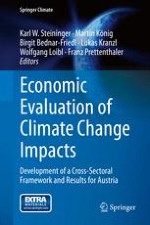2015 | OriginalPaper | Buchkapitel
21. Macroeconomic Evaluation of Climate Change in Austria: A Comparison Across Impact Fields and Total Effects
verfasst von : Gabriel Bachner, Birgit Bednar-Friedl, Stefan Nabernegg, Karl W. Steininger
Erschienen in: Economic Evaluation of Climate Change Impacts
Aktivieren Sie unsere intelligente Suche, um passende Fachinhalte oder Patente zu finden.
Wählen Sie Textabschnitte aus um mit Künstlicher Intelligenz passenden Patente zu finden. powered by
Markieren Sie Textabschnitte, um KI-gestützt weitere passende Inhalte zu finden. powered by
